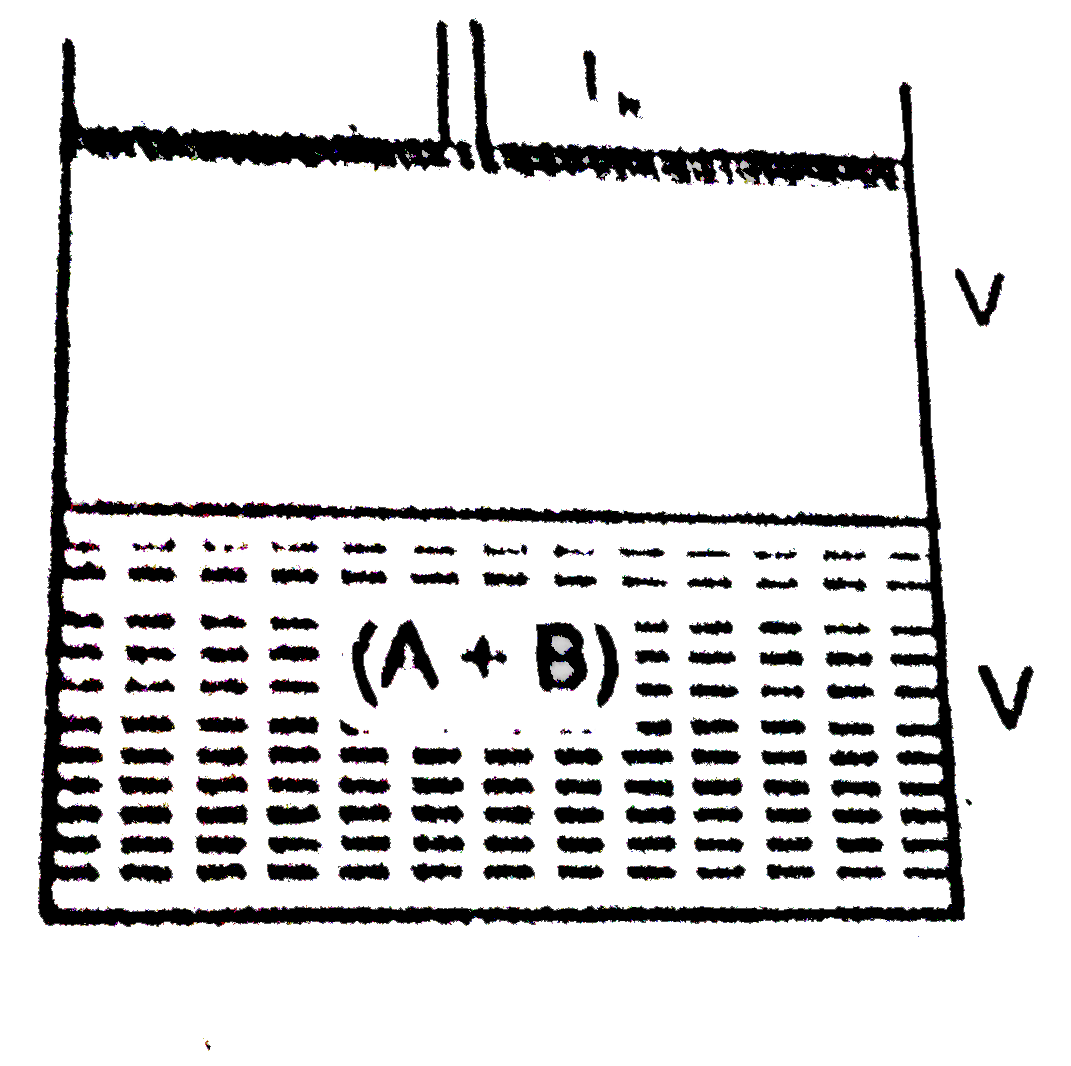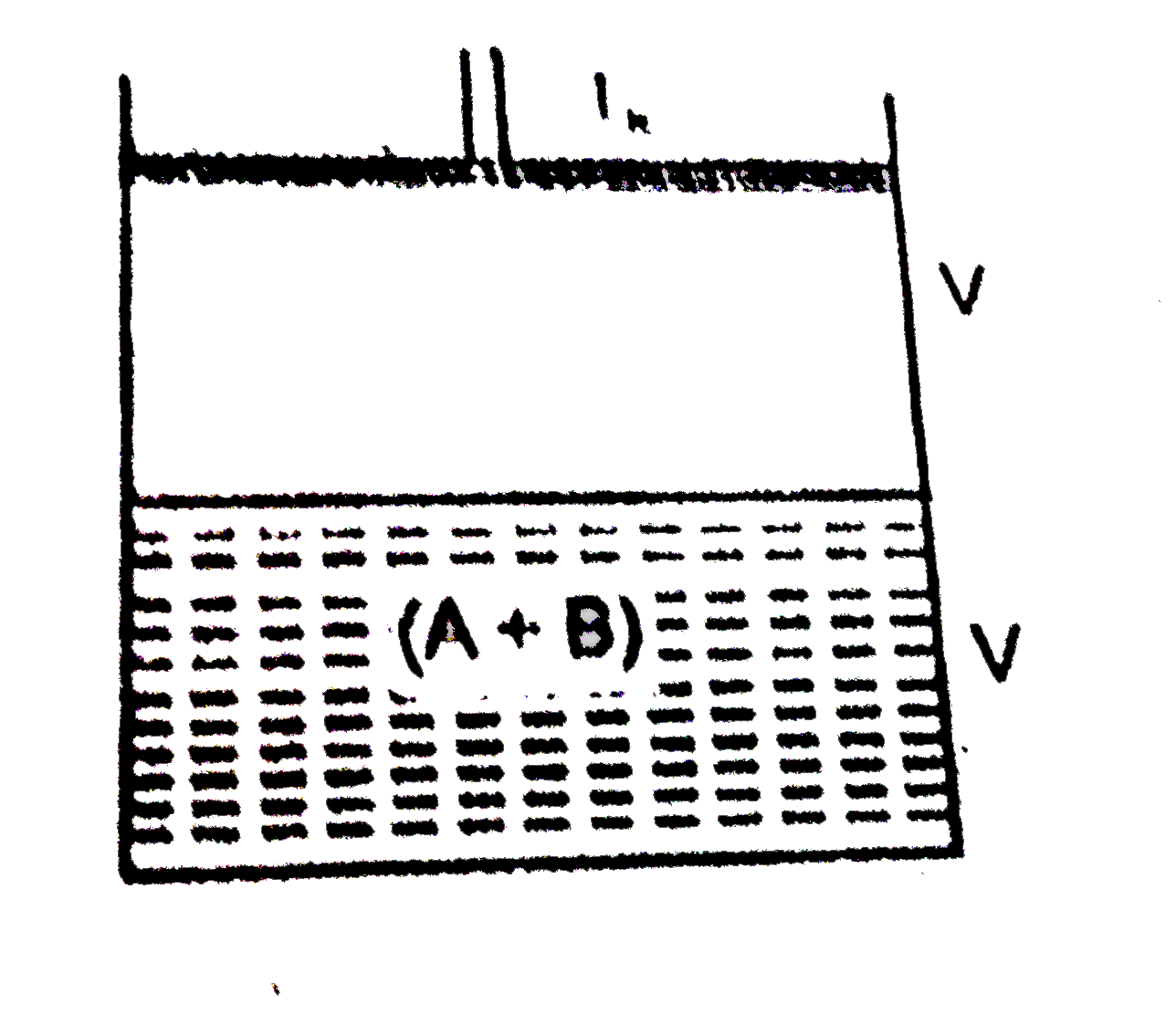The system shown in the figure is in equilibrium, where A and B are isomeric liquids and form an ideal solution at TK.standard vapour pressure of A and B are P∘AandP∘B respectively at TK.We collect the vapour of A and B in two container of volume V, first container is maintained at 2TK and second container is maintained at 3T2K.At the temperature greater than TK, both A and B exist in only gaseous form.Total vapour pressure of the system at TK is given as
P=P∘AXA+P∘BXB
where XAandXB are the mole fraction of A and B in a liquid mixture.
In container (1)
We assume that collected gases behave ideally at 2TK and there can take place isomerisation reaction in which A converted into B by first order kinetics
Reaction is given as
AA−−→B
In container (II)
At the given temperature 3T2,A and B are ideal in nature and non mixing in nature.A small pin hole is made into container.We can determine the initial rate of effusion of both gases in vaccum by the expression
r=kp√m
Where P= pressure difference between system and surrounding
K=positibe constant
M=Molecular weight of the gas.

If vapour is collected in container of volume 8.21 lit maintained at 75 K then ratio of initial rate of effusion of Gas A and B is given as :
2:1
1:2
4:1
1:4
The correct Answer is:A
rArB=PAPB√MBMA⇒rArB=nAnB√MBMA=(8/3)(4/3)√11
rArB=2
Topper's Solved these Questions
Similar Questions
The system shown in the figure is in equilibrium, where A and B are isomeric liquids and form an ideal solution at TK. Standard vapour pressures of A and B are P0A and P0B, respectively, at TK. We collect the vapour of A and B in two containers of volume V, first container is maintained at 2TK and second container is maintained at 3T/2. At the temperature greater than TK, both A and B exist in only gaseous form.
We assume than collected gases behave ideally at 2TK and there may take place an isomerisation reaction in which A gets converted into B by first-order kinetics reaction given as:
Ak−−→B, where k is a rate constant.
In container (II) at the given temperature 3T/2, A and B are ideal in nature and non reacting in nature. A small pin hole is made into container. We can determine the initial rate of effusion of both gases in vacuum by the expression

r=K.P√M0
where P= pressure differences between system and surrounding
K= positive constant
M0= molecular weight of the gas
If vapours are collected in a container of volume 8.21L maintained at 3T/2K, where T=50K, then the ratio of initial rate of effusion of gases A and B is given as
View SolutionThe system shown in the figure is in equilibrium, where A and B are isomeric liquids and form an ideal solution at TK. Standard vapour pressures of A and B are P0A and P0B, respectively, at TK. We collect the vapour of A and B in two containers of volume V, first container is maintained at 2TK and second container is maintained at 3T/2. At the temperature greater than TK, both A and B exist in only gaseous form.
We assume than collected gases behave ideally at 2TK and there may take place an isomerisation reaction in which A gets converted into B by first-order kinetics reaction given as:
Ak−−→B, where k is a rate constant.
In container (II) at the given temperature 3T/2, A and B are ideal in nature and non reacting in nature. A small pin hole is made into container. We can determine the initial rate of effusion of both gases in vacuum by the expression

r=K.P√M0
where P= pressure differences between system and surrounding
K= positive constant
M0= molecular weight of the gas
Vapours of A and B are passed into a container of volume 8.21L, maintained at 2TK, where T=50K and after 5min, moles of B=8/3. The pressure developed into the cotainer after two half lives is
View Solution
Knowledge Check
The system shown in the figure is in equilibrium, where A and B are isomeric liquids and form an ideal solution at TK.standard vapour pressure of A and B are P∘AandP∘B respectively at TK.We collect the vapour of A and B in two container of volume V, first container is maintained at 2TK and second container is maintained at 3T2K.At the temperature greater than TK, both A and B exist in only gaseous form.Total vapour pressure of the system at TK is given as
P=P∘AXA+P∘BXB
where XAandXB are the mole fraction of A and B in a liquid mixture.
In container (1)
We assume that collected gases behave ideally at 2TK and there can take place isomerisation reaction in which A converted into B by first order kinetics
Reaction is given as
AA−−→B
In container (II)
At the given temperature 3T2,A and B are ideal in nature and non mixing in nature.A small pin hole is made into container.We can determine the initial rate of effusion of both gases in vaccum by the expression
r=kp√m
Where P= pressure difference between system and surrounding
K=positibe constant
M=Molecular weight of the gas.
Vapour is collected and passed into a container of volume 8.21 lit, maintainer at 100 K and after 5 min number of mole of B=83.Then calculate pressure develop into the container after two half lives.A2 atmB4 atmC1 atmD0.5 atmThe system shown in the figure is in equilibrium, where A and B are isomeric liquids and form an ideal solution at TK.standard vapour pressure of A and B are P∘AandP∘B respectively at TK.We collect the vapour of A and B in two container of volume V, first container is maintained at 2TK and second container is maintained at 3T2K.At the temperature greater than TK, both A and B exist in only gaseous form.Total vapour pressure of the system at TK is given as
P=P∘AXA+P∘BXB
where XAandXB are the mole fraction of A and B in a liquid mixture.
In container (1)
We assume that collected gases behave ideally at 2TK and there can take place isomerisation reaction in which A converted into B by first order kinetics
Reaction is given as
AA−−→B
In container (II)
At the given temperature 3T2,A and B are ideal in nature and non mixing in nature.A small pin hole is made into container.We can determine the initial rate of effusion of both gases in vaccum by the expression
r=kp√m
Where P= pressure difference between system and surrounding
K=positibe constant
M=Molecular weight of the gas.

If partial vapour pressure of A is twice that of partial vapour pressure of B and total V.P. of equal to 2 at T=50 K and V=8.21 lit, then number of mole of A and B in vapour phase is :A83,43B3,1C2,2D1,3The system shown in the figure is in equilibrium, where A and B are isomeric liquids and form an ideal solution at TK. Standard vapour pressures of A and B are P0A and P0B, respectively, at TK. We collect the vapour of A and B in two containers of volume V, first container is maintained at 2TK and second container is maintained at 3T/2. At the temperature greater than TK, both A and B exist in only gaseous form.
We assume than collected gases behave ideally at 2TK and there may take place an isomerisation reaction in which A gets converted into B by first-order kinetics reaction given as:
Ak−−→B, where k is a rate constant.
In container (II) at the given temperature 3T/2, A and B are ideal in nature and non reacting in nature. A small pin hole is made into container. We can determine the initial rate of effusion of both gases in vacuum by the expression

r=K.P√M0
where P= pressure differences between system and surrounding
K= positive constant
M0= molecular weight of the gas
If vapours are collected in a container of volume 8.21L maintained at 3T/2K, where T=50K, then the ratio of initial rate of effusion of gases A and B is given asA2:1B1:1C4:3D2:4
Liquids A and B form an ideal solution in the entire composition range. At 350K, the vapour pressures of pure A and B are 9×103 Pa and 16×103 Pa, respectively. The composition of the vapour in equilibrium with a solution containing 30 mole percent of A at this temperature is:
View SolutionThe system shown in the figure is in equilibrium, where A and B are isomeric liquids and form an ideal solution at TK. Standard vapour pressures of A and B are P0A and P0B, respectively, at TK. We collect the vapour of A and B in two containers of volume V, first container is maintained at 2TK and second container is maintained at 3T/2. At the temperature greater than TK, both A and B exist in only gaseous form.
We assume than collected gases behave ideally at 2TK and there may take place an isomerisation reaction in which A gets converted into B by first-order kinetics reaction given as:
Ak−−→B, where k is a rate constant.
In container (II) at the given temperature 3T/2, A and B are ideal in nature and non reacting in nature. A small pin hole is made into container. We can determine the initial rate of effusion of both gases in vacuum by the expression

r=K.P√M0
where P= pressure differences between system and surrounding
K= positive constant
M0= molecular weight of the gas
Vapours of A and B are passed into a container of volume 8.21L, maintained at 2TK, where T=50K and after 5min, moles of B=8/3. The pressure developed into the cotainer after two half lives is
View SolutionThe system shown in the figure is in equilibrium, where A and B are isomeric liquids and form an ideal solution at TK. Standard vapour pressures of A and B are P0A and P0B, respectively, at TK. We collect the vapour of A and B in two containers of volume V, first container is maintained at 2TK and second container is maintained at 3T/2. At the temperature greater than TK, both A and B exist in only gaseous form.
We assume than collected gases behave ideally at 2TK and there may take place an isomerisation reaction in which A gets converted into B by first-order kinetics reaction given as:
Ak−−→B, where k is a rate constant.
In container (II) at the given temperature 3T/2, A and B are ideal in nature and non reacting in nature. A small pin hole is made into container. We can determine the initial rate of effusion of both gases in vacuum by the expression

r=K.P√M0
where P= pressure differences between system and surrounding
K= positive constant
M0= molecular weight of the gas
If partial vapour pressure of A is twice that of partial vapour pressure of B and total vapour pressure 2 atm at TK, where T=50K and V=8.21L, then the number of moles of A and B in vapour phase is:
View SolutionLiquids A and B form an ideal solution in the entire composition range. At 350K, the vapour pressures of pure A and B are 9×103 Pa and 16×103 Pa, respectively. The composition of the vapour in equilibrium with a solution containing 30 mole percent of A at this temperature is:
View SolutionWhich has maximum osmotic pressure at temperatureTK?
View Solution
